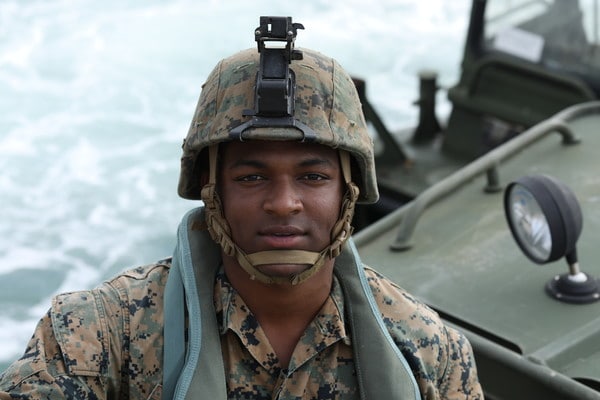
Naha Military Port, OKINAWA– —
Engines roared and calm blue water churned white as boats cruised under the bright Okinawa sun. Marines in groups of three piloted small green boats across the quiet industrial port, practicing elaborate patters of turns, spins, lateral movements and sudden stops.
Combat engineers with Improved Ribbon Bridge Platoon, Bridge Company, 9th Engineer Support Battalion, 3rd Marine Logistics Group practiced piloting bridge erection boats Jan. 29, 2019 at Naha Military Port. The Marines, designated as BEB operators, were tested on a series of maneuvers at the port in order to attain BEB licenses.
“We’re practicing maneuvers in the boats that allow us to move bridge bays into place during rafting and bridging operations,” said Cpl. Malon Johnson, a combat engineer with IRB Plt., Bridge Co., 9th ESB, 3rd MLG. “I’m out here working to earn my license with the rest of the Marines.”
BEBS are used to move and connect Improved Ribbon Bridge bays, which is a tactical bridging system that can span an across wet gaps, which are bodies of water, greater than 100 meters or can function as a raft to ferry vehicles and equipment across larger bodies of water.
The boat operators can use the BEBs to push individual IRB bays across bodies of water to get initial supplies and equipment to the opposite shore, then line up and connect the bays to create a sturdy bridge for units to transport across with the rest of their vehicles and equipment.
“The BEBs are highly maneuverable, highly agile and can move a significant amount of weight,” said 1st Lt. Daniel Asheim, the commanding officer of IRB Plt., Bridge Co. “As we license new BEB operators, we ensure we are mission capable by maintaining depth in our personnel readiness as well as taking the time to operationally check and maintain our gear.”
The boat operator licensing process begins with classroom instruction periods and written test, then the combat engineers move to Naha Military Port to complete the practical application portion of their testing.
“The practical application portion of the test starts with basic maneuvers, such as starting the boat and conducting preventative maintenance checks and services,” Asheim said. “From there, we move into more advanced maneuvers such as ‘crab-walking,’ which is moving the boat laterally across the water.”
According to Asheim, training the Bridge Co. combat engineers to think and react quickly provides an invaluable skill set to the unit as well as the III Marine Expeditionary Force area of operations.
“This licensing functional exercise really sets a baseline for readiness for our platoon, making sure we have licensed operators at all times,” Asheim said. It provides a mobility asset to [III Marine Expeditionary Force] and the MLG that allows us to foster logistics across a [body of water]. IRB operations and employment really benefits III MEF as a whole.”



